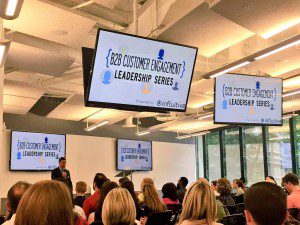 This week, Influitive hit the road to connect with more than 100 savvy marketers at Atlanta Tech Village, a progressive community hub and co-working office, housing 200+ tech startups.
This week, Influitive hit the road to connect with more than 100 savvy marketers at Atlanta Tech Village, a progressive community hub and co-working office, housing 200+ tech startups.
The B2B Customer Engagement Leadership Series featured a host of engaging speakers, including Megan Heuer, VP and Group Director at SiriusDecisions; Jessica Cooper, Senior Manager of Global Customer Advocacy at Alfresco; Angela Higgins, Customer Engagement Manager at Code42; Heather Pepe, Sales Enablement Manager at PGi and Sophie Brown, Customer Marketing Manager at Bomgar.
Over the coming weeks, we’ll bring you the insights of some of their illuminating presentations about why B2B customer experience is vital to the success of an organization and how brands can keep customers engaged.
For now, I’d like to share some of the top key takeaways from the event.
1. Marketing is once again becoming humanized
 Event moderator and VP of Marketing here at Influitive, Jim Williams, kicked things off by sharing his observations of the evolution of marketing. When he started, the discipline of marketing was akin to “arts and crafts”. The focus was on investing in cool-looking websites, developing collateral and attending industry tradeshows. In essence, these things were designed to engage with customers.
Event moderator and VP of Marketing here at Influitive, Jim Williams, kicked things off by sharing his observations of the evolution of marketing. When he started, the discipline of marketing was akin to “arts and crafts”. The focus was on investing in cool-looking websites, developing collateral and attending industry tradeshows. In essence, these things were designed to engage with customers.
However, as we moved further into the digital age, everything became trackable. New technologies and analytics allowed companies to automate many marketing functions as well as establish campaign ROI. Marketing quickly transformed from art to science.
Today, another shift is taking place. Marketers are realizing that numbers don’t tell the whole story. Instead, we must look at the entire customer journey. This will take marketers back to where we started, to a more emotional, humanized form of marketing where true and lasting connections are made between brands and customers.
2. We’re underinvesting in the customer experience
 Megan presented a compelling argument: customer engagement is the single best investment you can make in your growth strategy.
Megan presented a compelling argument: customer engagement is the single best investment you can make in your growth strategy.
SiriusDecisions’ 2015 B-to-B Buying Study asked respondents, “What was the most significant driver of decision to select your vendor of choice?” The study revealed that a staggering 71% of B-to-B decision drivers are based on direct or indirect customer experience; making it your best secret weapon for filling the sales pipeline.
Despite the fact that 83% of respondents said references are “critical” or “valuable” to the sales cycle, the majority still allocate less than 10% of the marketing budget to customer engagement. This is a disconnect that companies seeking growth can’t afford to ignore.
3. Customer complaints are valuable too
 According to Angela, sometimes the clients who complain a lot are your most valuable assets. Sure, it’s easy to give your top supporters all the glory, but it’s often your harshest critics that can teach you the biggest lessons. They can offer insight into what needs fixing within your product or service.
According to Angela, sometimes the clients who complain a lot are your most valuable assets. Sure, it’s easy to give your top supporters all the glory, but it’s often your harshest critics that can teach you the biggest lessons. They can offer insight into what needs fixing within your product or service.
By ensuring that their voices are heard and taking their concerns back to the product development team, your company can end up with a better product.
Additionally, the complainers are often viewed as more believable to other customers. Today, it’s so easy for unscrupulous brands to pay for good reviews—and savvy customers are starting to catch on. Suspicions arise if there are nothing but rave reviews for a product or service. Having some negative and/or neutral comments peppered in gives your engagement program more credibility.
4. It’s up to you to empower your customers

 Heather and Sophie sat down with Jim for a lively “fireside chat” (actual fire excluded).
Heather and Sophie sat down with Jim for a lively “fireside chat” (actual fire excluded).
One of the most powerful messages to come out of the discussion was that customers want to advocate on your behalf, you just need to give them a platform to do it. Advocacy or customer engagement is driven by the larger trend of social community within the current sharing economy. Today’s customers don’t always need to be asked to share their experiences, it’s been ingrained in them to do so, via word-of-mouth, social media or online review sites.
An organization with a commitment to customer engagement can benefit from launching a branded platform, to serve as mission central—a place where you can meet your customers, engage with them, as well as ask for, collect and implement their invaluable feedback.
5. There must be an alignment of people, process & technology
 To close out the day, Jessica shared her company’s journey to setting up the foundations of a customer experience strategy. She spoke about the importance of gaining buy-in from internal stakeholders within the sales, marketing and customer service departments.
To close out the day, Jessica shared her company’s journey to setting up the foundations of a customer experience strategy. She spoke about the importance of gaining buy-in from internal stakeholders within the sales, marketing and customer service departments.
Jessica also touched on the significance of developing a mission statement for your customer experience initiative, in an effort to map its course and to get all of the people involved on the same page and moving in the same direction.
She wrapped up by highlighting the importance of putting the proper tools in place to elevate the good things your customers are saying about you. All three of these components must be properly aligned in order to execute a successful customer engagement program.
Engaging B2B customers can seem daunting, but it really comes down to one thing: “The number one takeaway for me is the love; we’ve got to give more love to our customers,” said event attendee Veronica Kirn, Global Portfolio Market Manager at IBM B2B Cloud Services. “That equates to demand creation and to revenue. Leaving here, I’m motivated to push the envelope and become much more engaged with my SaaS customers, long-term.”












































